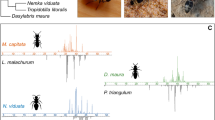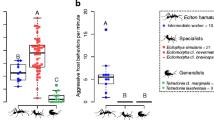Abstract
The aim of this paper is to describe the relationship between two ant species, Formica frontalis and Iberoformica subrufa, found together in shared nests. Therefore, we obtained data from dug nests and outdoor activity in two sympatric populations and investigated the cuticular hydrocarbons (CHCs) in both sympatric populations and in 10 I. subrufa allopatric populations to unravel whether the relationship becomes tuned between both species. We also determined the CHCs of two sympatric Serviformica species (F. cunicularia and F. lemani). Our results showed that the ant F. frontalis is a temporary parasite of I. subrufa which facultatively forms mixed colonies complying with a loose form of the Emery’s rule. Alkanes and methylalkanes are the most abundant compounds found in F. frontalis and I. subrufa CHCs, respectively, but esters were only abundant in I. subrufa. As far as the CHC similarity is concerned, the sympatric free-living hosts were chemically closer to the parasite, albeit not identical, whereas the allopatric I. subrufa populations always maintained a separate CHC composition. We provide different potential hypotheses to explain this similarity of cuticular profiles only in the two geographically distant sympatric populations.







Similar content being viewed by others
References
Arnan X, Rodrigo A, Retana J (2007) Uncoupling the effects of shade and food resources of vegetation on Mediterranean ants: an experimental approach at the community level. Ecography 30:161–172
Bagnères AG, Morgan ED, Clément JL (1991) Species-specific secretions of the Dufour gland of three species of Formicinae ants (Hymenoptera:Formicidae). Biochem Syst Ecol 19:25–33
Buczkowski G, Kumar R, Suib SL, Silverman J (2005) Diet-related modification of cuticular hydrocarbon profiles of the Argentine ant, Linepithema humile, diminishes intercolony aggression. J Chem Ecol 31:829–843
Buschinger A (1986) Evolution of social parasitism in ants. Trends Ecol Evol 1(6):155–160
Buschinger A (2009) Social parasitism among ants: a review (Hymenoptera: Formicidae). Myrmecol News 12:219–235
Chernenko A, Helanterä H, Sundström L (2011) Egg recognition and social parasitism in Formica ants. Ethology 117:1081–1092
Cini A, Nieri R, Dapporto L, Monnin T, Cervo R (2014) Almost royal: incomplete suppression of host worker ovarian development by a social parasite wasp. Behav Ecol Sociobiol 68(3):467–475
Collingwood CA (1979) The Formicidae (Hymenoptera) of Fennoscandia and Denmark. Fauna Entomol Scand 8:1–174
Czechowski W, Godzińska EJ (2015) Enslaved ants: not as helpless as they were thought to be. Insectes Sociaux 62(1):9–22
Emery C (1909) Über den Ursprung der dulotischen, parasitischen und myrmekophilen Ameisen. Biol Cent 29:352–362
Forel A (1874) Les fourmis de la Suisse. Systématique, notices anatomique et physiologiques, architecture, distribution géographique, nouvelles expériences et observations de moeurs. Neue Denkschr. Allg. Scweiz. Ges Gesammten Naruwiss 26:1–452
Forel A (1886) Études Myrmécologiques en 1886. Ann Soc Entomol Belg 30:131–215
Forel A (1900) Fourmis du Japon. Nids en toile. Strongylognathus Huberi et voisins. Fourmiliére triple. Cyphomyrmex Wheeleri. Fourmis importées. Mitteilungen Der Schweizerischen Entomologischen Gesellschaft 10:267–287
Forel A (1913) Notes sur quelques Formica. Ann Soc Entomol Belg 57:360–361
Gökcen OA, Morgan ED, Dani FR, Agosti D, Wehner R (2002) Dufour gland contents of ants of the Cataglyphis bicolor group. J Chem Ecol 28:71–87
Goropashnaya AV, Fedorov VB, Seifert B, Pamilo P (2012) Phylogenetic relationships of palaearctic Formica species (Hymenoptera, Formicidae) based on mitochondrial cytochrome b sequences. PLoS One 7:1–7
Higashi S (1983) Mechanism underlaying the appearance of secondary polygyny in subgenus Formica ants. Environ Sci Hokkaido 6:1–13
Holldobler B, Wilson EO (1990) The ants. Harvard University Press, Cambridge, p 732
Huang MH, Dornhaus A (2008) A meta-analysis of ant social parasitism: host characteristics of different parasitism types and a test of Emery’s rule. Ecol Entomol 33:589–596
Ito F, Higashi S (1990) Temporary social parasitism in the enslaving ant species Formica sanguinea Latreille: an important discovery related to the evolution of Dulosis in Formica ants. J Ethol 8:33–35
Kather R, Martin SJ (2012) Cuticular hydrocarbon profiles as a taxonomic tool: advantages, limitations and technical aspects. Physiol Entomol 37:25–32
Kilner RM, Langmore NE (2011) Cuckoos versus hosts in insects and birds: adaptations, counter-adaptations and outcomes. Biol Rev 86:836–852
Le Masne G (1956) Recherches sur les fourmis parasites: Plagiolepis grassei et l’évolution des Plagiolepis parasites, 243. Comptes Rendus de l’Académie des Sciences, Paris, pp 673–675
Lenoir A, D’Ettorre P, Errard C, Hefetz A (2001) Chemical ecology and social parasitism in ants. Annu Rev Entomol 46:573–599
Liang D, Silverman J (2000) “You are what you eat”: diet modifies cuticular hydrocarbons and nestmate recognition in the Argentine ant, Linepithema humile. Naturwissenschaften 87:412–416
Lopez-Osorio F, Perrard A, Pickett KM, Carpenter JM, Agnarsson I (2015) Phylogenetic tests reject Emery’s rule in the evolution of social parasitism in yellowjackets and hornets (Hymenoptera:Vespidae, Vespinae). R Soc Open Sci 2:150159
Martin SJ, Helanterä H, Drijfhout FP (2008) Evolution of species-specific cuticular hydrocarbon patterns in Formica ants. Biol J Lin Soc 95:131–140
Martin SJ, Helanterä H, Drijfhout FP (2011) Is parasite pressure a driver of chemical cue diversity in ants? Proc R Soc Lond B Biol Sci 278(1705):496–503
Martin SJ, Vitikainen E, Drijfhout FP, Jackson D (2012) Conspecific ant aggression is correlated with chemical distance, but not with genetic or spatial distance. Behav Genet 42(2):323–331
Mori A, Grasso DA, Visicchio R, Le Moli F (2001) Comparison of reproductive strategies and raiding behaviour in facultative and obligatory slave-making ants: the case of Formica sanguinea and Polyergus rufescens. Insectes Soc 48:302–314
Muñoz-López M, Palomeque T, Carrillo JA, Pons J, Tinaut A, Lorite P (2012) A new taxonomic status for Iberoformica (Hymenoptera, Formicidae) based on the use of molecular markers. J Zool Syst Evol Res 50(1):30–37
Pamminger T, Foitzik S, Metzler D, Pennings PS (2014) Oh sister, where art thou? Spatial population structure and the evolution of an altruistic defence trait. J Evol Biol 27(11):2443–2456
Pherobase (2017) http://www.pherobase.com/. Accessed 26 May 2017
Pisarski B, Czechowski W (1994) Ways to reproductive success of wood ant queens. Memorab Zool 48(48):181–186
Regnier FE, Wilson EO (1971) Chemical communication and ‘‘propaganda’’ in slave-maker ants. Science 172:267–269
Romiguier J, Rolland J, Morandin C, Keller L (2018) Phylogenomics of palearctic Formica species suggests a single origin of temporary parasitism and gives insights to the evolutionary pathway toward slave-making behaviour. BMC Evol Biol 18(1):40
Savolainen R, Deslippe JR (1996) Facultative and obligate slavery in Formicine ants: frequency of slavery, and proportion and size of slaves. Biol J Lin Soc 57:47–58
Stockan JA, Robinson EJ, Trager JC, Yao I, Seifert B (2016) Introducing wood ants: evolution, phylogeny, identification and distribution. In: Stockan J, Robinson EJ (eds) Wood ant ecology and conservation. Cambridge University Press, Cambridge, pp 1–35
Svensson EI, Råberg L (2010) Resistance and tolerance in animal enemy–victim coevolution. Trends Ecol Evol 25:267–274
Tinaut A (1990) Descripción del macho de Formica subrufa Roger, 1859 y creación de un nuevo subgénero (Hymenoptera, Formicidae). Eos 65:281–291
Tinaut A, Martínez Ibáñez MD (1998) Taxonomy and distribution of Formica dusmeti Emery, 1909 and of F. frontalis Santschi, 1919 (Hymenoptera, Formicidae). Graellsia 54:31–41
Tinaut A, Ruano F (1992) Braquipterismo y apterismo en formicidos. Morfología y biometría en las hembras de especies ibéricas de vida libre (Hymenoptera: Formicidae). Graellsia 48:121–131
Tinaut A, Ruano F, Silvestre M, Martínez Ibañez MD (2015) Distribución de Formica frontalis Santschi, 1919 en la península ibérica (Hymenoptera: Formicidae). Boletín Asociación española de Entomología 39(1–2):115–133
van Zweden JS, Dreier S, d’Ettorre P (2009) Disentangling environmental and heritable nestmate recognition cues in a carpenter ant. J Insect Physiol 55:159–164
Wilson EO (1971) The insect societies. Harvard University Press, Cambridge
Włodarczyk T (2011) Recognition of individuals from mixed colony by Formica sanguinea and Formica polyctena ants. J Insect Behav 25(2):105–113
Włodarczyk T, Szczepaniak L (2014) Incomplete homogenization of chemical recognition labels between Formica sanguinea and Formica rufa ants (Hymenoptera:Formicidae) living in a mixed colony. J Insect Sci 14(1):214
Zamora-Muñoz C, Ruano F, Errard C, Lenoir A, Hefetz A, Tinaut A (2003) Coevolution in the slave-parasite system Proformica longiseta–Rossomyrmex minuchae (Hymenoptera:Formicidae). Sociobiology 42:299–317
Acknowledgements
We are grateful to Abraham Hefetz for his collaboration with identifying the esters, editing the manuscript, and discussing the resistance-tolerance hypothesis, which has significantly improved the manuscript. Raphaël Boulay and David Tinaut collected samples of Iberoformica subrufa at different sites in Spain. We are also grateful to the authorities of the Environmental Agency of the Andalusian Government and especially the National Parks of Sierra Nevada, Sierra de Baza and Doñana, who gave permission and facilities to collect samples. Fran Oi and Hugo Álvarez helped us to manage some graphs and tables and Angela Tate edited the English language as a professional scientific editor. This work was supported by the PRES Centre Val de Loire Université (APR-IA 2012).
Author information
Authors and Affiliations
Corresponding author
Electronic supplementary material
Below is the link to the electronic supplementary material.
Rights and permissions
About this article
Cite this article
Ruano, F., Lenoir, A., Silvestre, M. et al. Chemical profiles in Iberoformica subrufa and Formica frontalis, a new example of temporary host–parasite interaction. Insect. Soc. 66, 223–233 (2019). https://doi.org/10.1007/s00040-018-00677-6
Received:
Revised:
Accepted:
Published:
Issue Date:
DOI: https://doi.org/10.1007/s00040-018-00677-6




